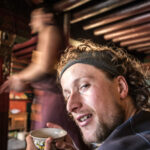Garze County, also known as Ganzi in the right pronounciation, was our starting point for this quest.
The good thing about a minivan terminal is that the endpoint is most of the time a new starting point.
The challenging part is, as often before, the linguistic maze.
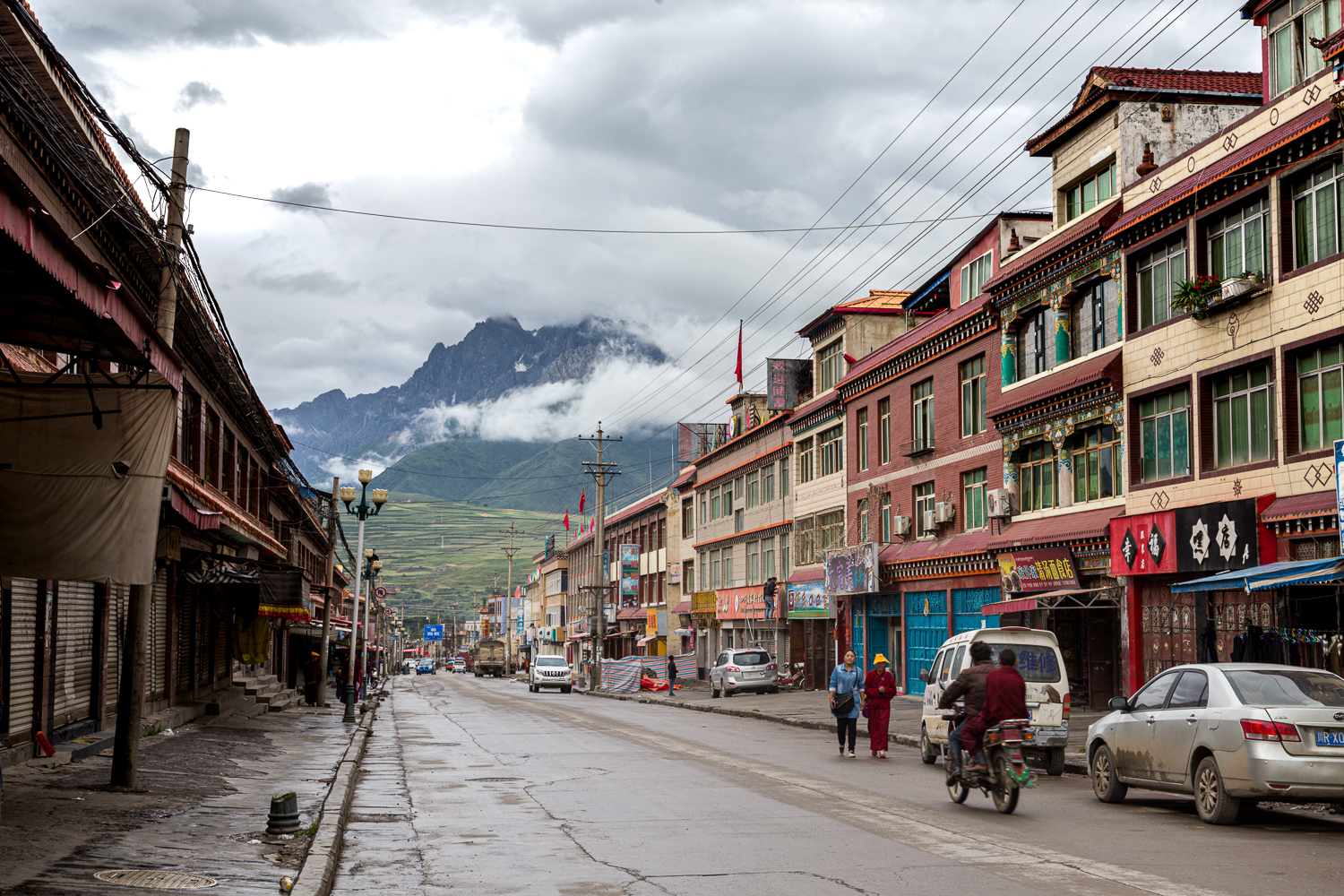
Ganzi, our starting point for this adventure
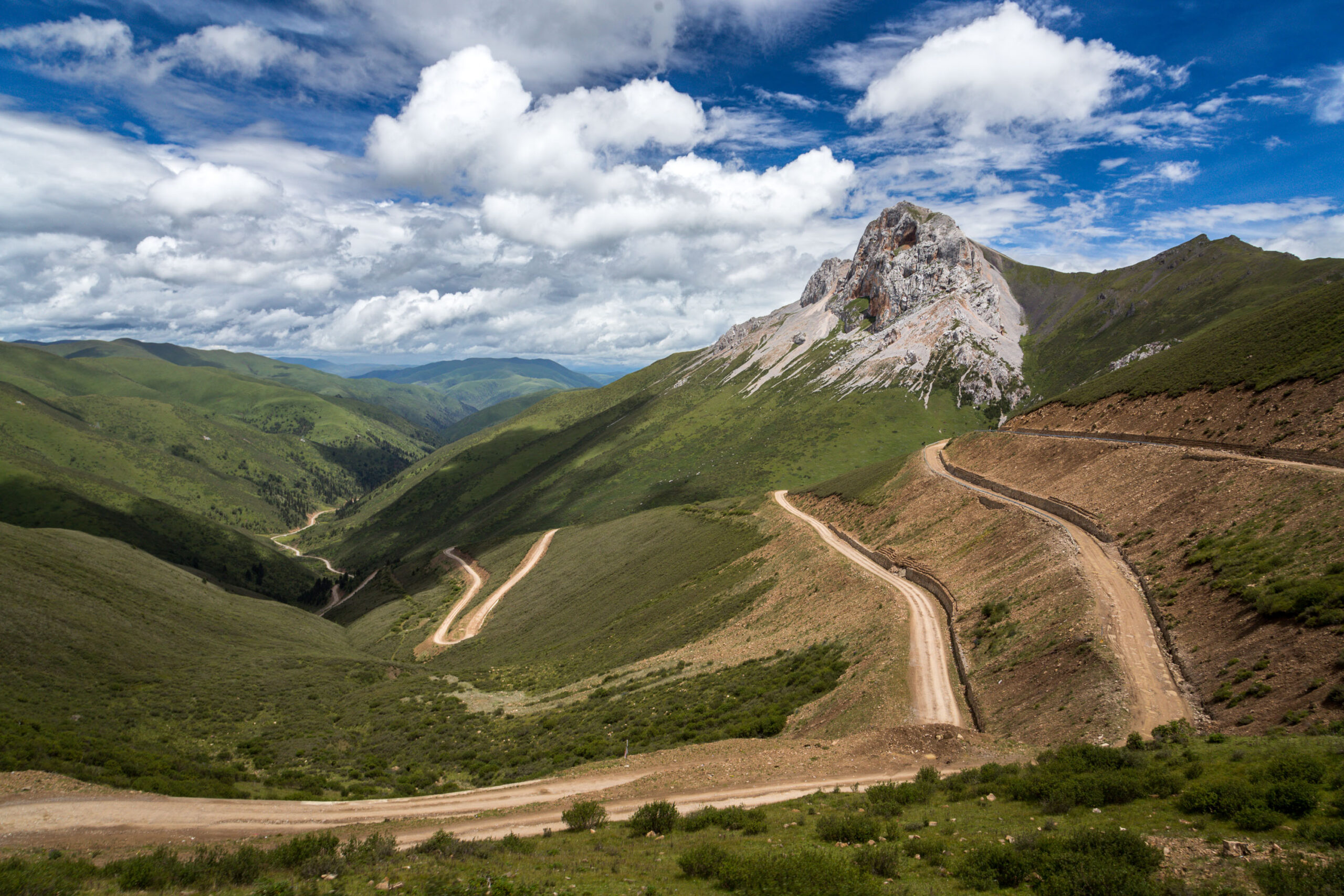
The road to Sertar! Roads have been known to be bumpier, views to be less impressive.
“Sertar? Seda? Larung Gar?” That’s what we were asking the mini-van drivers in Ganzi.
Finally someone understood where we wanted to go and showed us which shared minibus was going that way. Two hours, two monks and four nuns later we finally left for a four-hour drive.
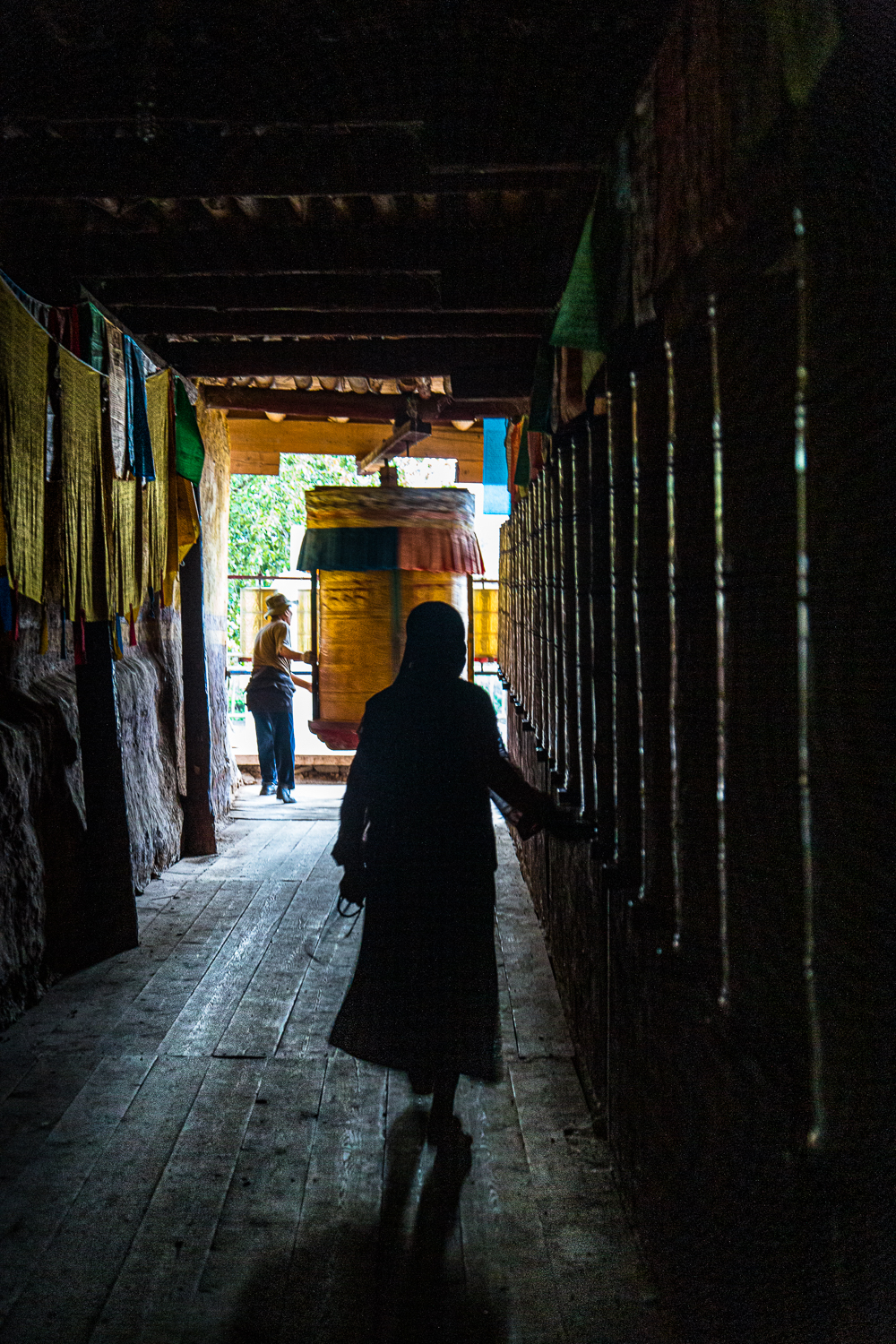
The prayers wheels are turned, as always, clockwise (exept for this one place in China (Danba) where they do it the other way around).
Once arrived in Sertar City — not our final destination — we dropped in a place where Tibetan restaurants, minibuses and prayer wheels are abundantly present. So far nothing very different from what we have already seen on this trip, but still impressive to see the Tibetan people circumambulate endlessly around the stupa.
The same terminal-departure protocol was respected: searching as fast as possible the right minibus and, once found, wait for it to get repleted (sometimes several hours). After a while it was time again to squeeze four monks, six nuns, two pilgrims, two children, and two ill-placed Western tourists in a minibus without forgetting the backpacks and the blood-dripping bag of fresh meat!

‘Om Mani Padme Hum’ is spread by the prayers into the world, so that everyone can take this peaceful message to their inner selves.
After a 20min- bumpy-road-construction-ride, we entered the valley and were immediately impressed by the endless amount of red houses;
destination reached: Larung Gar Monastery,
officially known as “Serta Larung Five Science Buddhist Academy”.
A panoramic view of the ‘Larung Gar Monastery’, also seen by this equally astonished monk.
Overwhelmed by this cityscape we started our way up to the only hotel to find a room for tonight. We asked a nun for directions and, to our surprise, she spoke fairly good English and accompanied us all the way up (and even carried one of our bags — no way stopping her!).
This hotel was, in contrast to the beautiful wooden red houses, a big luxurious place; marble floors, big Chinese signs, kitschy furniture, and worst of all: fully booked!
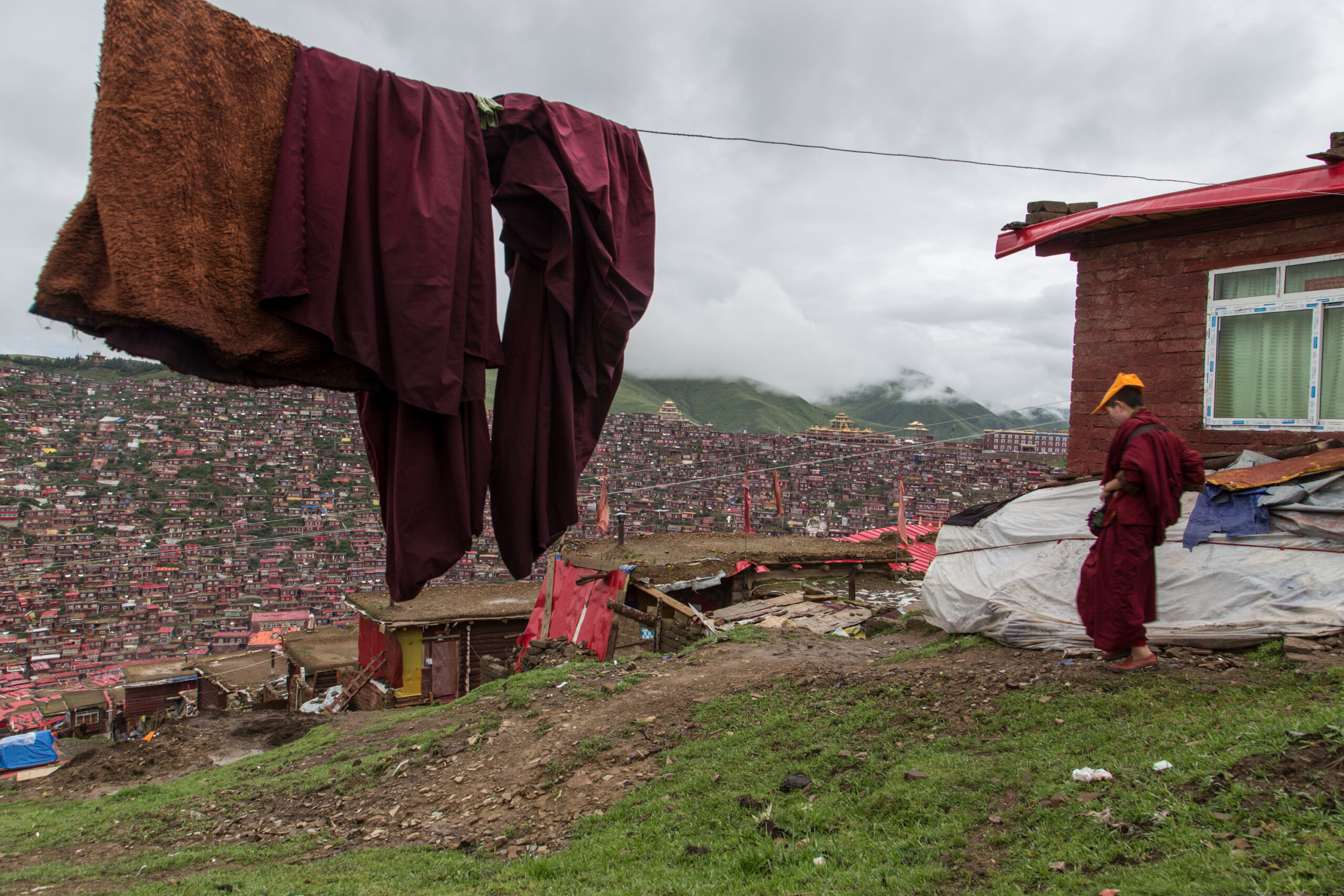
At the borders of this Buddhist settlement the daily life continued and laundry didn’t dry…

Traces of an ongoing demolishing and rebuilding are seen everywhere.
No other obvious hotels around, so we started looking for an alternative. Luckily we encountered the same nun who helped us earlier and she knew another place to sleep, but only women were allowed…
As Larung Gar is at an elevation of 4000m, a little panic outbreak on our side was slightly present. Even the – not so welcoming – basement of the hotel stuffed with floor matrasses and sick pilgrim Tibetans.
We were at a point where we didn’t directly correlate travel with discovery and adventure.
But as always there is hope for a miracle to happen and after a few I-phone-calls, the helpful nun told us she found a place for us, one of the tiny red houses (yesyesyes)! An unexpected delightful dream come true!

An outside view from within our very welcome sleeping place!
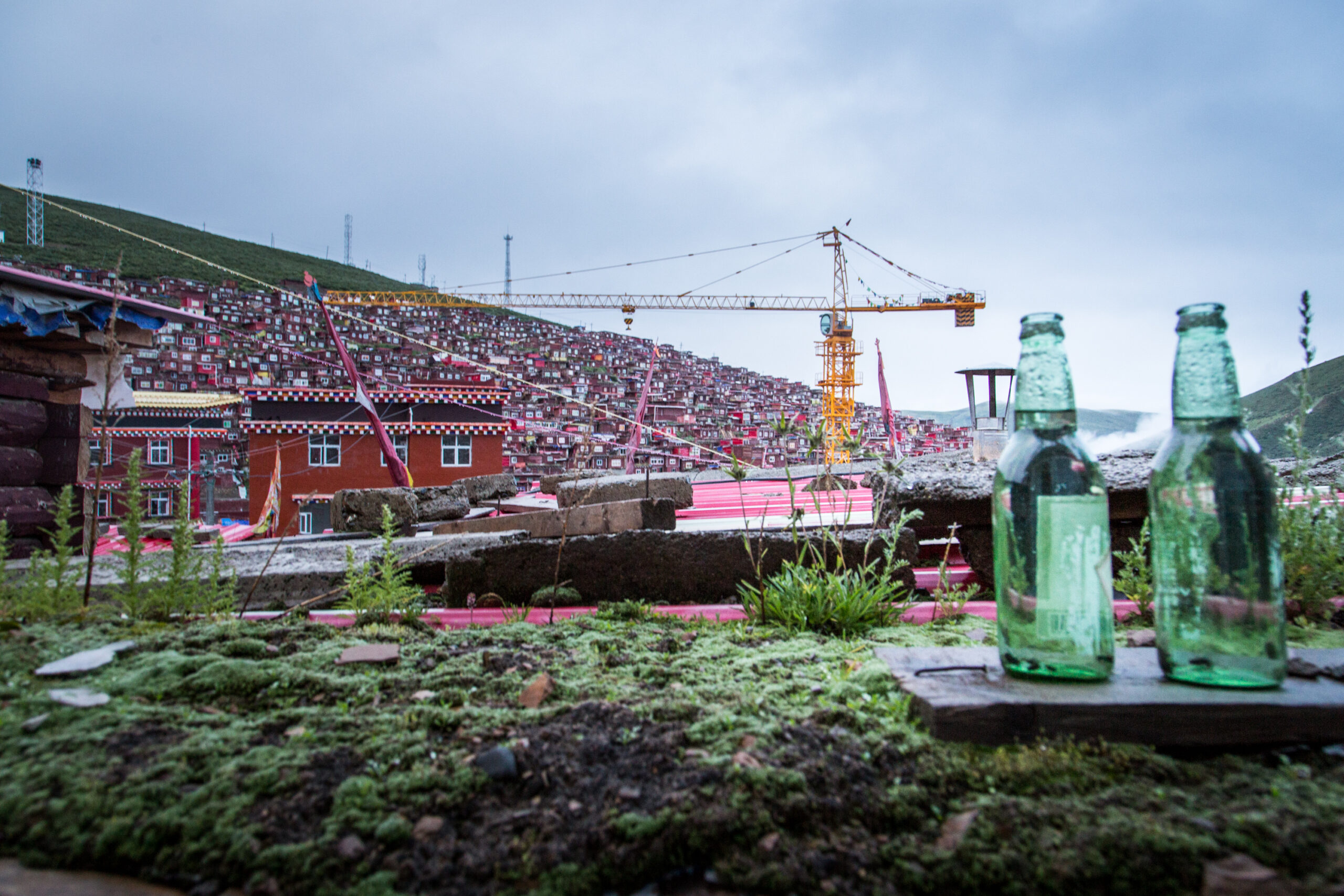
Panoramic view from our sleeping place (with fresh drinking water on the green terrace)! The construction crane is a witness to the local building boom.
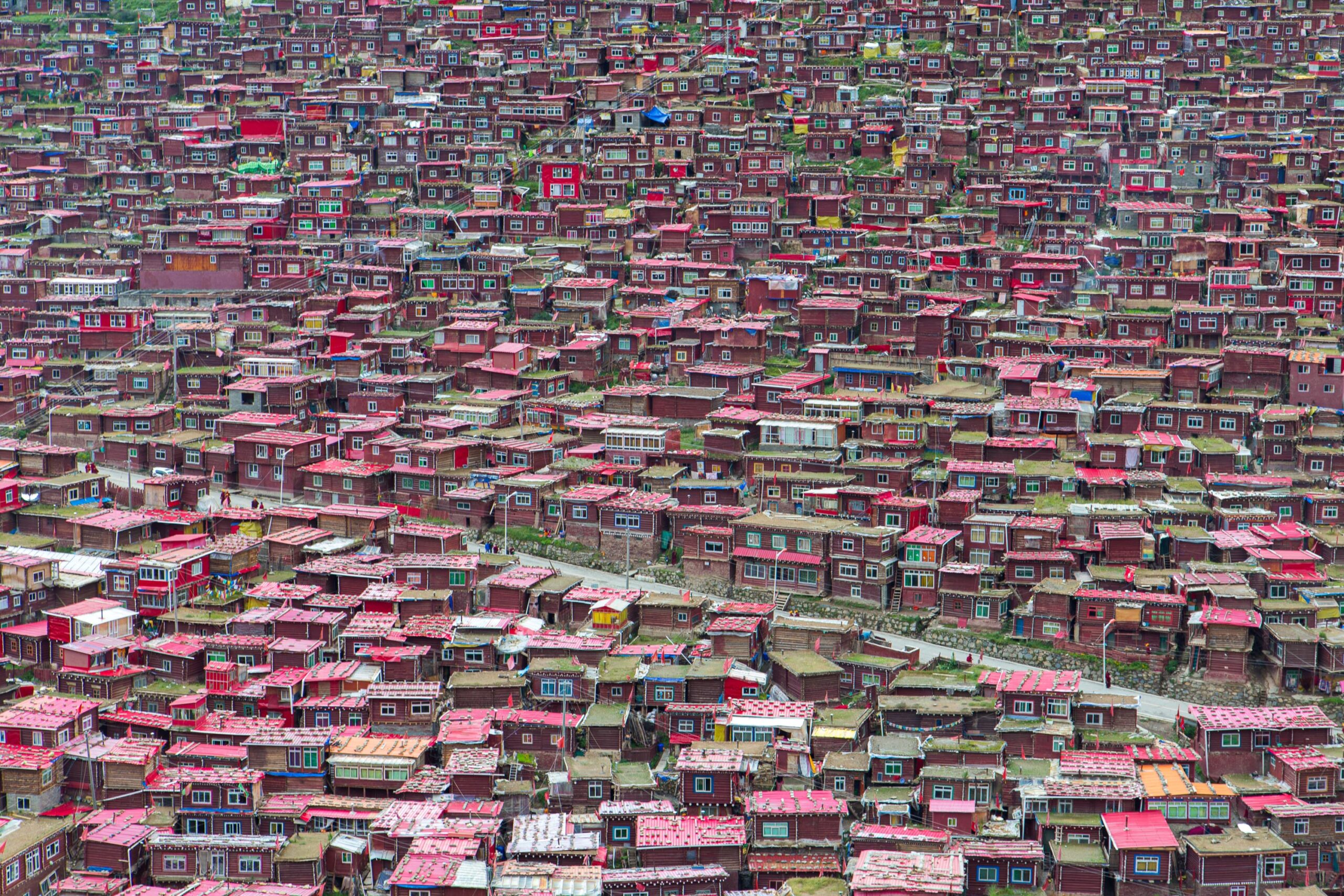
The apparently endless religious network, intersected only by a lonely street.
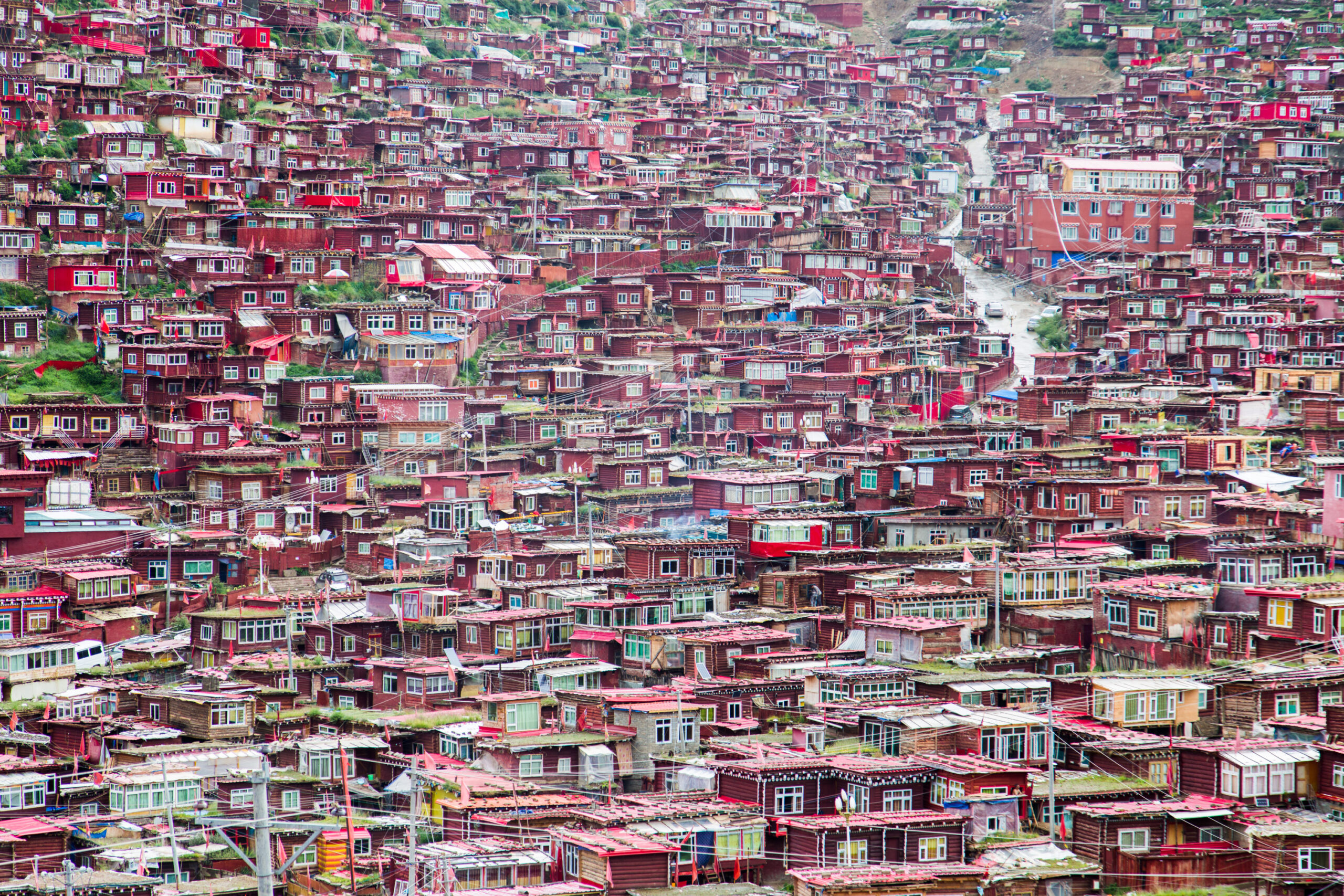
One can imagine that we were happy that we could sleep in one of these lovely houses, to find it was another challenge.
As a bonus she gave us a personal tour of Larung Gar and was pleased to answer our questions about the institute and Buddhism. She was very friendly and helpful and she was… Chinese (you know: Han, not Tibetan).
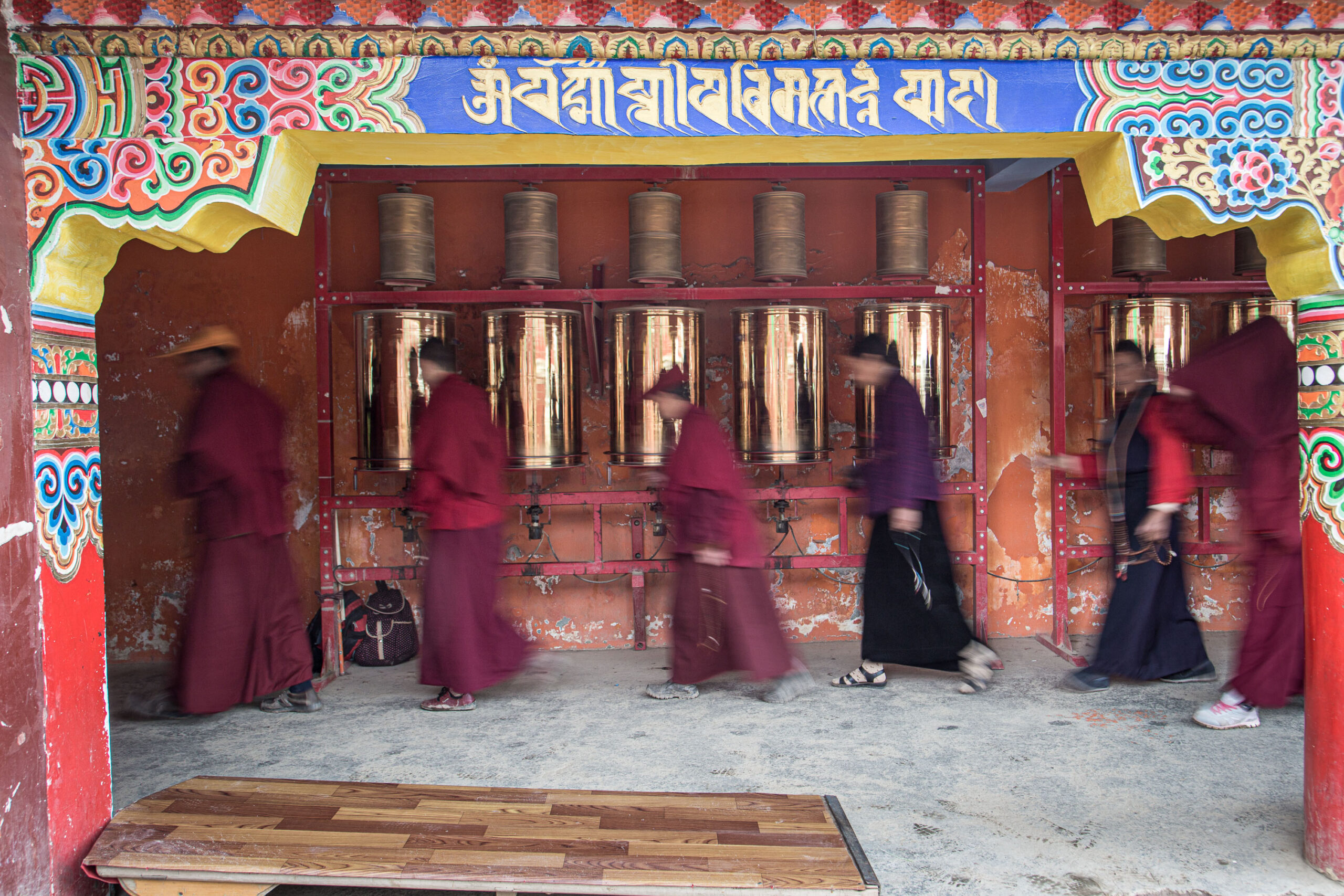
Prayer wheels: legend says that some monks practiced night shift to keep them turning…
She originally came from Chengdu, had studied over there (including English) and was very dedicated to become a good Buddhist nun.
The evening fell and she showed us the way to a good viewpoint over the Institute. Daylight faded away, and little by little the interior lights of the houses made it a very special view!
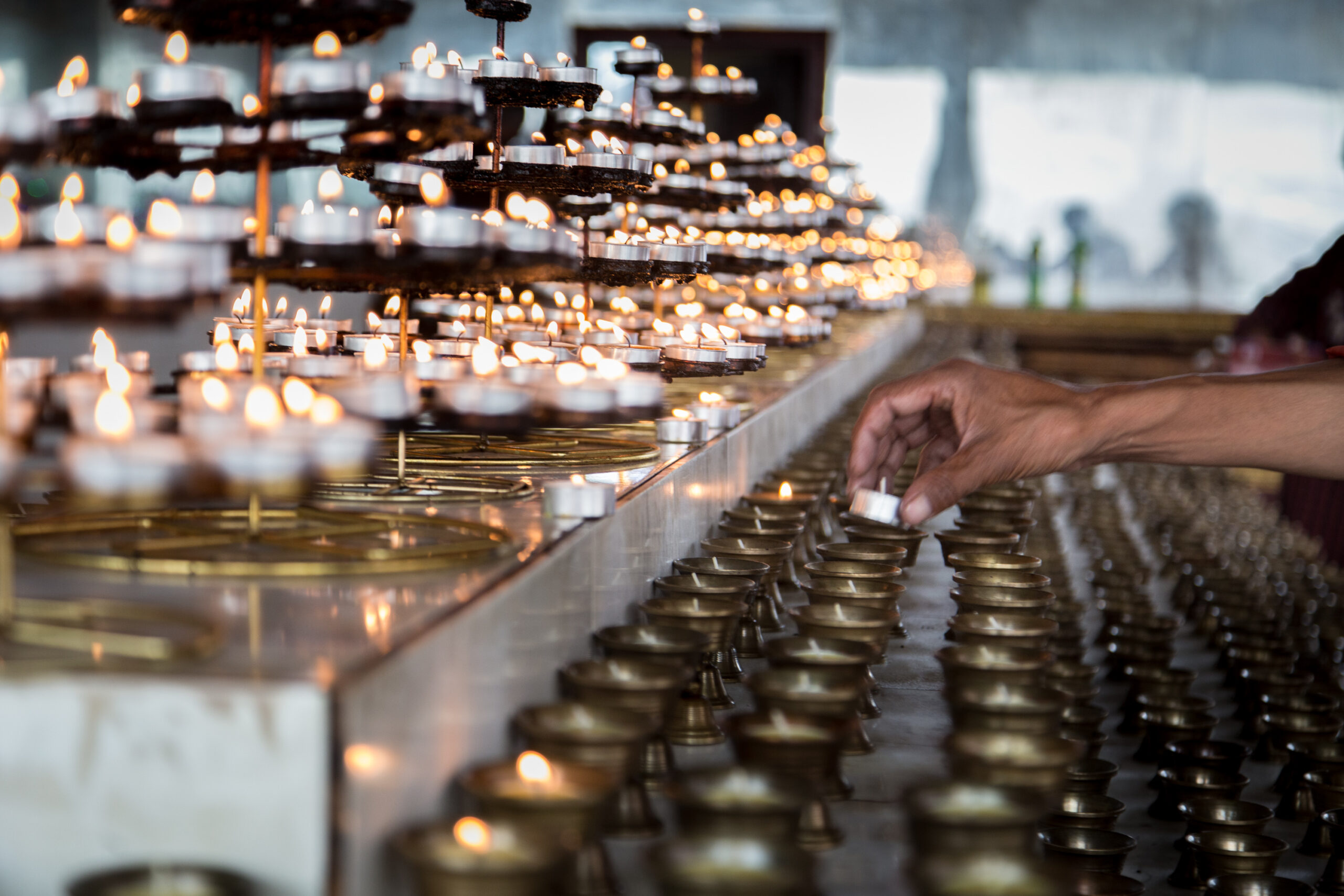
The enlightening of the ever-lasting burning candles.
This helpful nun, which we even thank today, managed to find us a place to sleep. Thanks to her, we were back in adventure modus!
The Larung Gar Buddhist Institute is probably the largest religious institute in the world.
The nuns and monks come here to study and practice Buddhist religion (or should I say philosophy), meaning: praying, eating tsampa, praying, reading old Tibetan writings, turning prayer wheels, meditating (while praying).
The monks and nuns were all very happy when they could help us and there was clearly a mutual curiosity between our very different cultures. However, more than in other parts of Kham, there seemed to be a bigger stand-off between us and them. Were they afraid that we would ask them awkward questions about the political situation in Tibet or was it just an apprehension for the photographer’s soul-capturing device?
The little red house with the tiny windows was our sleeping place…
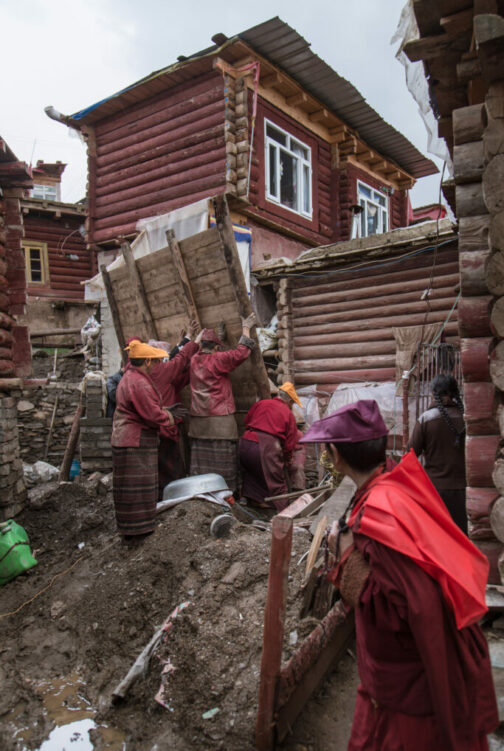
Nuns collaborate to rebuild one of the residences. A fire, or even a common earthquake demolishes very easily these wooden houses.
Not seldom, due to an electrical short circuit or a misplaced candle, a fire breaks out in one of the houses. Given the proximity of other houses the nuns and monks try to react as soon as possible to limit the damage to the Larung Gar institute. Luckily the houses are rebuilt just a few days after they burn down to ashes.
Mao couldn’t prevent people from practicing Buddhism and neither can a fire.
A few years ago the Chinese government placed a concrete fence around the institute to limit the explosive growth of red houses and the increasing popularity of this Buddhist center. But I’m sure that the intense faith in the religion enables the monks and nuns to come up with creative solutions to circumvent this obstacle.
Since a few years more Han-Chinese citizens are interested in Buddhism. Little by little they replace the Tibetan monks in Larung Gar (up to 30%), partly because they are allowed to build new houses, where Tibetans cannot.
Could this be a new way of controlling the Tibetan region in a taste of controlled freedom or is it just an genuine interest of Han-Chinese in Buddhism?
Whatever the reason, it seems a peacekeeping evolution that might be interesting for both sides.
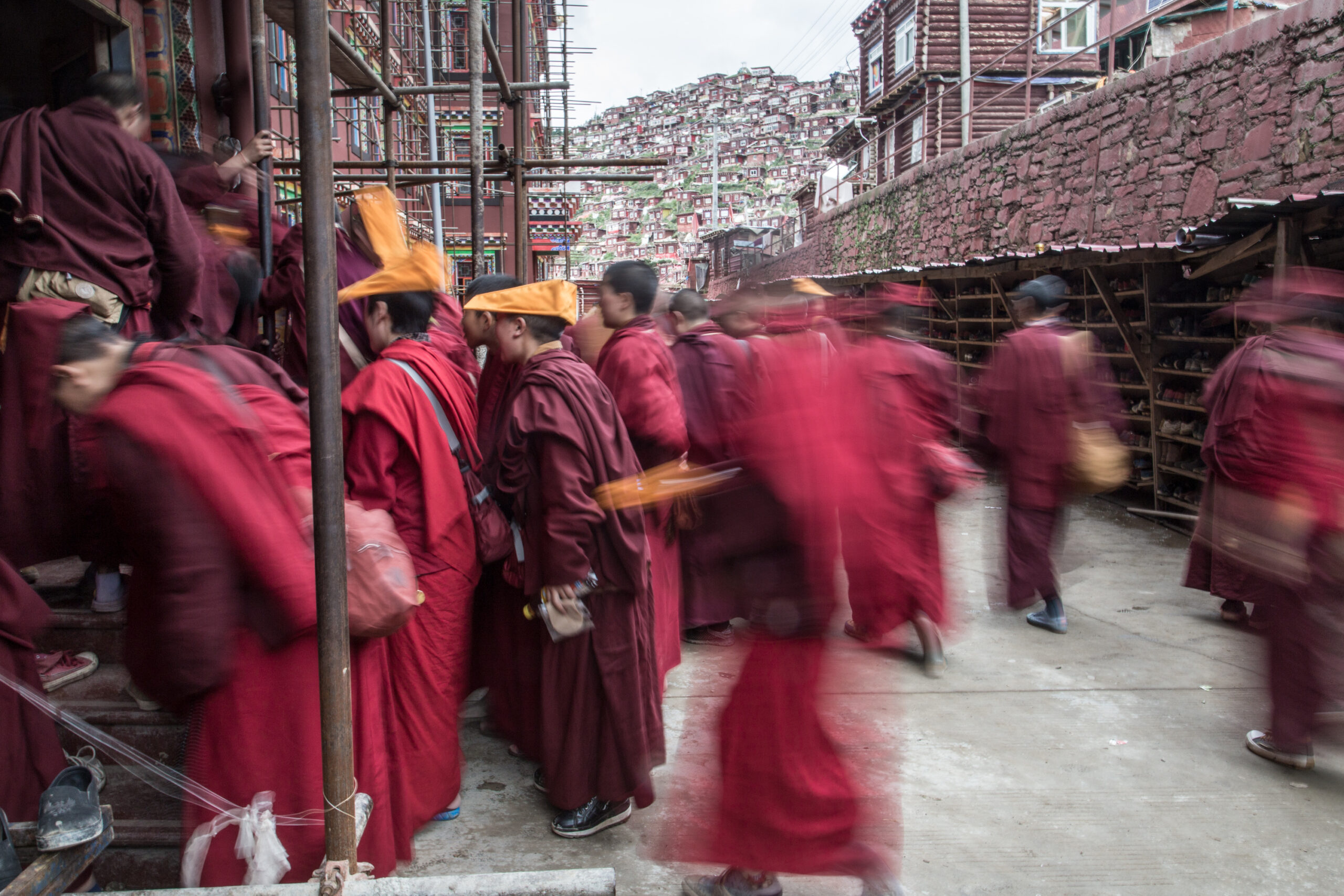
Nuns and monks gathering for the praying classes to begin, no shoes allowed.
During the classes they read prayers -written in their traditional pliable serigraph books- louder and more dedicated than usual.
It’s not difficult to imagine that their synchronized voices bring them in a sort of trance.
As Western-European it is unusual to experience the well-organized lives of the nuns and monks in this magnitude. No other Western tourists were present at the time we visited the institute, which is not surprising considering that guidebooks just mention this in a small paragraph as being something to visit if you have some time to kill. Chinese tourists on the contrary visit in herds, hence the fully booked hotel.

Nuns collaborate to rebuild one of the residences. A fire, or even a common earthquake demolishes very easily these wooden houses.
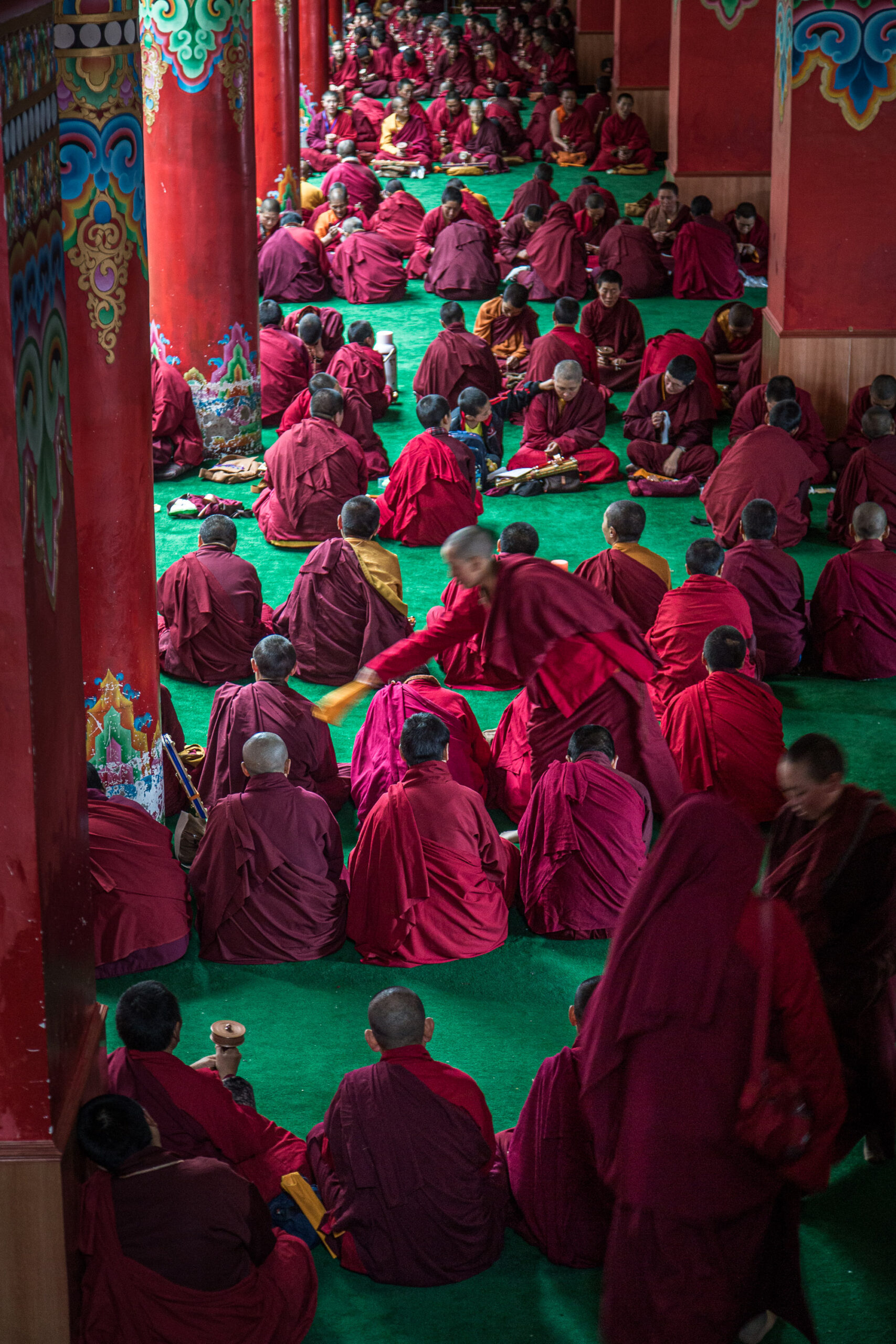
all these Buddhist students listen to each other’s prayer chants.

